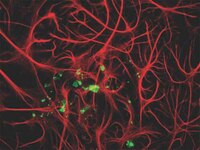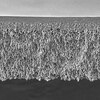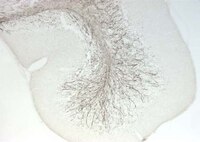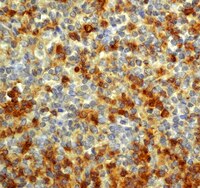Cuprizone-induced demyelination and demyelination-associated inflammation result in different proton magnetic resonance metabolite spectra.
Praet, J; Orije, J; Kara, F; Guglielmetti, C; Santermans, E; Daans, J; Hens, N; Verhoye, M; Berneman, Z; Ponsaerts, P; Van der Linden, A
NMR in biomedicine
28
505-13
2015
Show Abstract
Conventional MRI is frequently used during the diagnosis of multiple sclerosis but provides only little additional pathological information. Proton MRS ((1) H-MRS), however, provides biochemical information on the lesion pathology by visualization of a spectrum of metabolites. In this study we aimed to better understand the changes in metabolite concentrations following demyelination of the white matter. Therefore, we used the cuprizone model, a well-established mouse model to mimic type III human multiple sclerosis demyelinating lesions. First, we identified CX3 CL1/CX3 CR1 signaling as a major regulator of microglial activity in the cuprizone mouse model. Compared with control groups (heterozygous CX3 CR1(+/-) C57BL/6 mice and wild type CX3 CR1(+/+) C57BL/6 mice), microgliosis, astrogliosis, oligodendrocyte cell death and demyelination were shown to be highly reduced or absent in CX3 CR1(-/-) C57BL/6 mice. Second, we show that (1) H-MRS metabolite spectra are different when comparing cuprizone-treated CX3 CR1(-/-) mice showing mild demyelination with cuprizone-treated CX3 CR1(+/+) mice showing severe demyelination and demyelination-associated inflammation. Following cuprizone treatment, CX3 CR1(+/+) mice show a decrease in the Glu, tCho and tNAA concentrations as well as an increased Tau concentration. In contrast, following cuprizone treatment CX3 CR1(-/-) mice only showed a decrease in tCho and tNAA concentrations. Therefore, (1) H-MRS might possibly allow us to discriminate demyelination from demyelination-associated inflammation via changes in Tau and Glu concentration. In addition, the observed decrease in tCho concentration in cuprizone-induced demyelinating lesions should be further explored as a possible diagnostic tool for the early identification of human MS type III lesions. | | 25802215
 |
Functionally distinct PI 3-kinase pathways regulate myelination in the peripheral nervous system.
Heller, BA; Ghidinelli, M; Voelkl, J; Einheber, S; Smith, R; Grund, E; Morahan, G; Chandler, D; Kalaydjieva, L; Giancotti, F; King, RH; Fejes-Toth, AN; Fejes-Toth, G; Feltri, ML; Lang, F; Salzer, JL
The Journal of cell biology
204
1219-36
2014
Show Abstract
The PI 3-kinase (PI 3-K) signaling pathway is essential for Schwann cell myelination. Here we have characterized PI 3-K effectors activated during myelination by probing myelinating cultures and developing nerves with an antibody that recognizes phosphorylated substrates for this pathway. We identified a discrete number of phospho-proteins including the S6 ribosomal protein (S6rp), which is down-regulated at the onset of myelination, and N-myc downstream-regulated gene-1 (NDRG1), which is up-regulated strikingly with myelination. We show that type III Neuregulin1 on the axon is the primary activator of S6rp, an effector of mTORC1. In contrast, laminin-2 in the extracellular matrix (ECM), signaling through the α6β4 integrin and Sgk1 (serum and glucocorticoid-induced kinase 1), drives phosphorylation of NDRG1 in the Cajal bands of the abaxonal compartment. Unexpectedly, mice deficient in α6β4 integrin signaling or Sgk1 exhibit hypermyelination during development. These results identify functionally and spatially distinct PI 3-K pathways: an early, pro-myelinating pathway driven by axonal Neuregulin1 and a later-acting, laminin-integrin-dependent pathway that negatively regulates myelination. | | 24687281
 |
The 4.1B cytoskeletal protein regulates the domain organization and sheath thickness of myelinated axons.
Einheber, S; Meng, X; Rubin, M; Lam, I; Mohandas, N; An, X; Shrager, P; Kissil, J; Maurel, P; Salzer, JL
Glia
61
240-53
2013
Show Abstract
Myelinated axons are organized into specialized domains critical to their function in saltatory conduction, i.e., nodes, paranodes, juxtaparanodes, and internodes. Here, we describe the distribution and role of the 4.1B protein in this organization. 4.1B is expressed by neurons, and at lower levels by Schwann cells, which also robustly express 4.1G. Immunofluorescence and immuno-EM demonstrates 4.1B is expressed subjacent to the axon membrane in all domains except the nodes. Mice deficient in 4.1B have preserved paranodes, based on marker staining and EM in contrast to the juxtaparanodes, which are substantially affected in both the PNS and CNS. The juxtaparanodal defect is evident in developing and adult nerves and is neuron-autonomous based on myelinating cocultures in which wt Schwann cells were grown with 4.1B-deficient neurons. Despite the juxtaparanodal defect, nerve conduction velocity is unaffected. Preservation of paranodal markers in 4.1B deficient mice is associated with, but not dependent on an increase of 4.1R at the axonal paranodes. Loss of 4.1B in the axon is also associated with reduced levels of the internodal proteins, Necl-1 and Necl-2, and of alpha-2 spectrin. Mutant nerves are modestly hypermyelinated and have increased numbers of Schmidt-Lanterman incisures, increased expression of 4.1G, and express a residual, truncated isoform of 4.1B. These results demonstrate that 4.1B is a key cytoskeletal scaffold for axonal adhesion molecules expressed in the juxtaparanodal and internodal domains that unexpectedly regulates myelin sheath thickness. | | 23109359
 |
Lentiviral vector-mediated gradients of GDNF in the injured peripheral nerve: effects on nerve coil formation, Schwann cell maturation and myelination.
Eggers, R; de Winter, F; Hoyng, SA; Roet, KC; Ehlert, EM; Malessy, MJ; Verhaagen, J; Tannemaat, MR
PloS one
8
e71076
2013
Show Abstract
Although the peripheral nerve is capable of regeneration, only a small minority of patients regain normal function after surgical reconstruction of a major peripheral nerve lesion, resulting in a severe and lasting negative impact on the quality of life. Glial cell-line derived neurotrophic factor (GDNF) has potent survival- and outgrowth-promoting effects on motoneurons, but locally elevated levels of GDNF cause trapping of regenerating axons and the formation of nerve coils. This phenomenon has been called the "candy store" effect. In this study we created gradients of GDNF in the sciatic nerve after a ventral root avulsion. This approach also allowed us to study the effect of increasing concentrations of GDNF on Schwann cell proliferation and morphology in the injured peripheral nerve. We demonstrate that lentiviral vectors can be used to create a 4 cm long GDNF gradient in the intact and lesioned rat sciatic nerve. Nerve coils were formed throughout the gradient and the number and size of the nerve coils increased with increasing GDNF levels in the nerve. In the nerve coils, Schwann cell density is increased, their morphology is disrupted and myelination of axons is severely impaired. The total number of regenerated and surviving motoneurons is not enhanced after the distal application of a GDNF gradient, but increased sprouting does result in higher number of motor axon in the distal segment of the sciatic nerve. These results show that lentiviral vector mediated overexpression of GDNF exerts multiple effects on both Schwann cells and axons and that nerve coil formation already occurs at relatively low concentrations of exogenous GDNF. Controlled expression of GDNF, by using a viral vector with regulatable GDNF expression, may be required to avoid motor axon trapping and to prevent the effects on Schwann cell proliferation and myelination. | Immunohistochemistry | 23951085
 |
Global and 3D spatial assessment of neuroinflammation in rodent models of Multiple Sclerosis.
Gupta, S; Utoft, R; Hasseldam, H; Schmidt-Christensen, A; Hannibal, TD; Hansen, L; Fransén-Pettersson, N; Agarwal-Gupta, N; Rozell, B; Andersson, A; Holmberg, D
PloS one
8
e76330
2013
Show Abstract
Multiple Sclerosis (MS) is a progressive autoimmune inflammatory and demyelinating disease of the central nervous system (CNS). T cells play a key role in the progression of neuroinflammation in MS and also in the experimental autoimmune encephalomyelitis (EAE) animal models for the disease. A technology for quantitative and 3 dimensional (3D) spatial assessment of inflammation in this and other CNS inflammatory conditions is much needed. Here we present a procedure for 3D spatial assessment and global quantification of the development of neuroinflammation based on Optical Projection Tomography (OPT). Applying this approach to the analysis of rodent models of MS, we provide global quantitative data of the major inflammatory component as a function of the clinical course. Our data demonstrates a strong correlation between the development and progression of neuroinflammation and clinical disease in several mouse and a rat model of MS refining the information regarding the spatial dynamics of the inflammatory component in EAE. This method provides a powerful tool to investigate the effect of environmental and genetic forces and for assessing the therapeutic effects of drug therapy in animal models of MS and other neuroinflammatory/neurodegenerative disorders. | | 24124545
 |
Spatiotemporal evolution of early innate immune responses triggered by neural stem cell grafting.
Reekmans, K; De Vocht, N; Praet, J; Fransen, E; Le Blon, D; Hoornaert, C; Daans, J; Goossens, H; Van der Linden, A; Berneman, Z; Ponsaerts, P
Stem cell research & therapy
3
56
2012
Show Abstract
Transplantation of neural stem cells (NSCs) is increasingly suggested to become part of future therapeutic approaches to improve functional outcome of various central nervous system disorders. However, recently it has become clear that only a small fraction of grafted NSCs display long-term survival in the (injured) adult mouse brain. Given the clinical invasiveness of NSC grafting into brain tissue, profound characterisation and understanding of early post-transplantation events is imperative to claim safety and efficacy of cell-based interventions.Here, we applied in vivo bioluminescence imaging (BLI) and post-mortem quantitative histological analysis to determine the localisation and survival of grafted NSCs at early time points post-transplantation.An initial dramatic cell loss (up to 80% of grafted cells) due to apoptosis could be observed within the first 24 hours post-implantation, coinciding with a highly hypoxic NSC graft environment. Subsequently, strong spatiotemporal microglial and astroglial cell responses were initiated, which stabilised by day 5 post-implantation and remained present during the whole observation period. Moreover, the increase in astrocyte density was associated with a high degree of astroglial scarring within and surrounding the graft site. During the two-week follow up in this study, the NSC graft site underwent extensive remodelling with NSC graft survival further declining to around 1% of the initial number of grafted cells.The present study quantitatively describes the early post-transplantation events following NSC grafting in the adult mouse brain and warrants that such intervention is directly associated with a high degree of cell loss, subsequently followed by strong glial cell responses. | | 23241452
 |















 acetylacetonate[802699_Copper(II) acetylacetonate-ALL].jpg)






